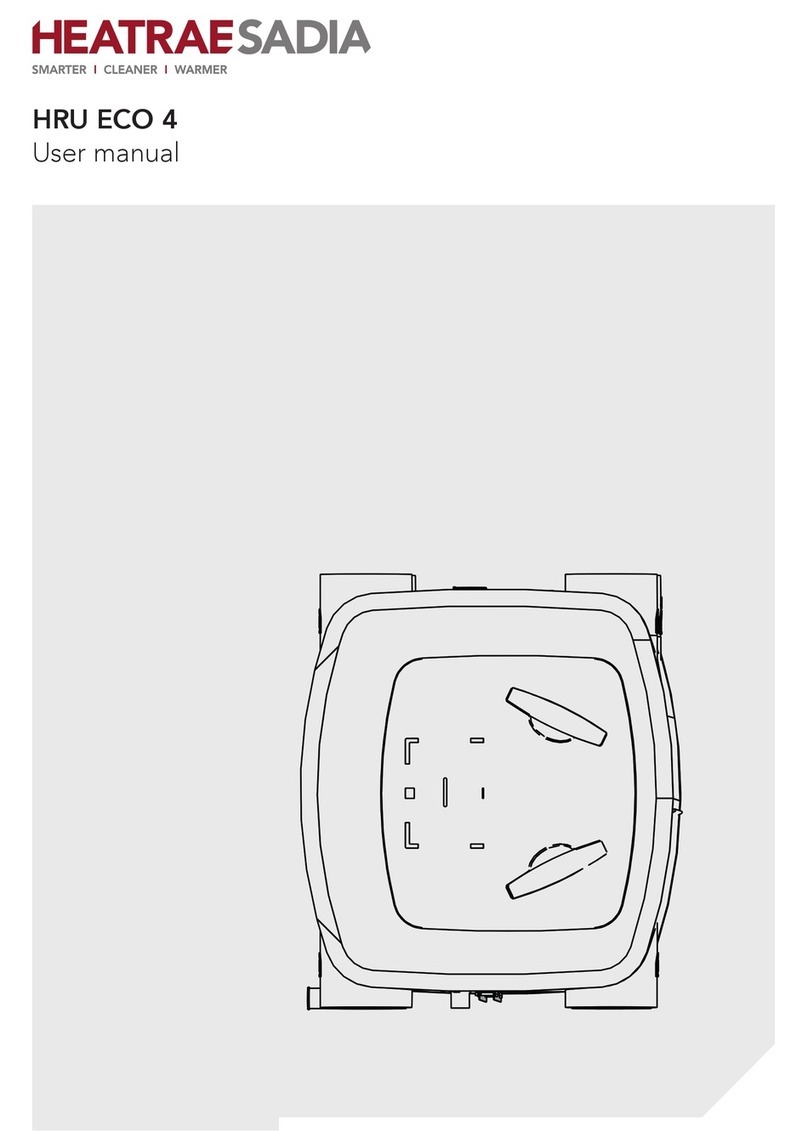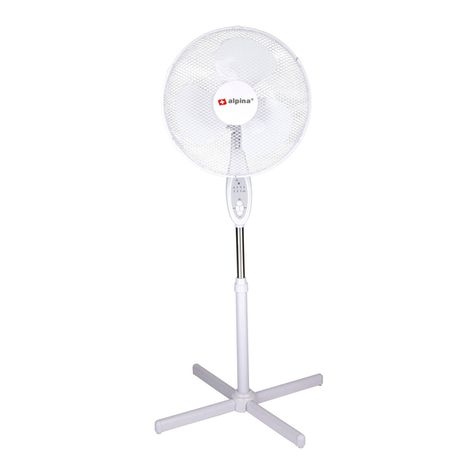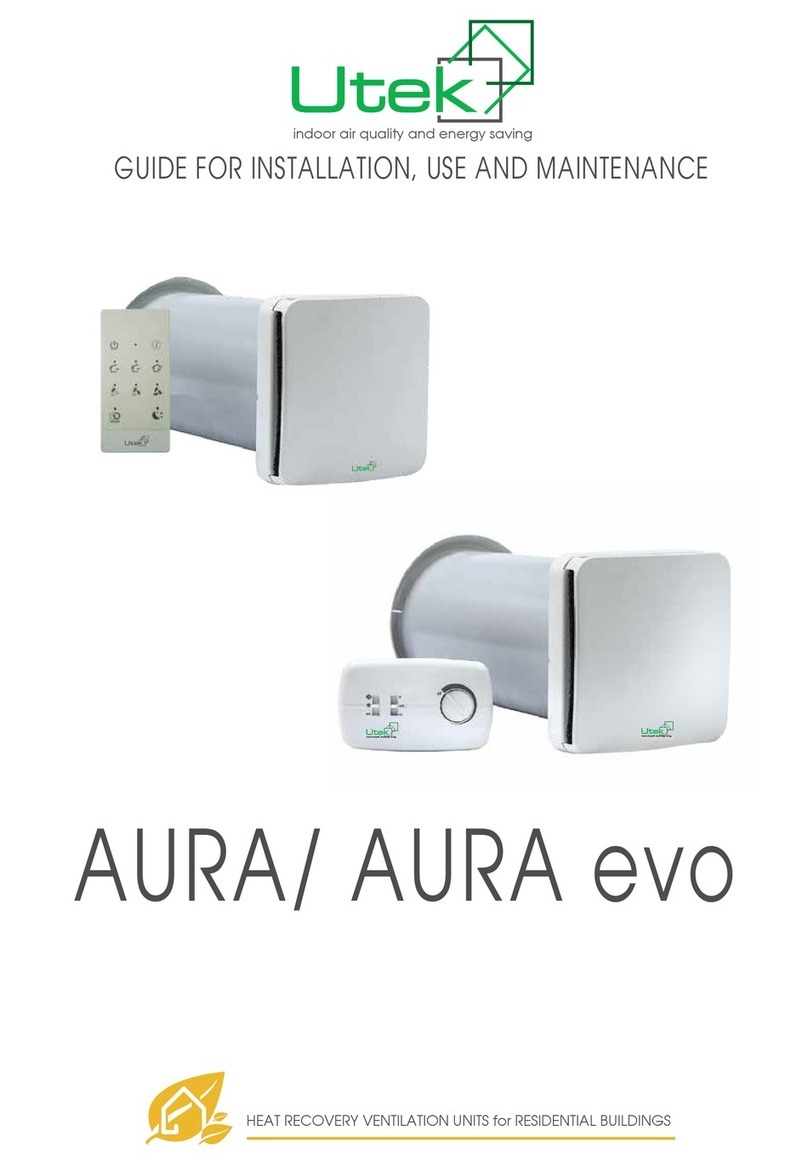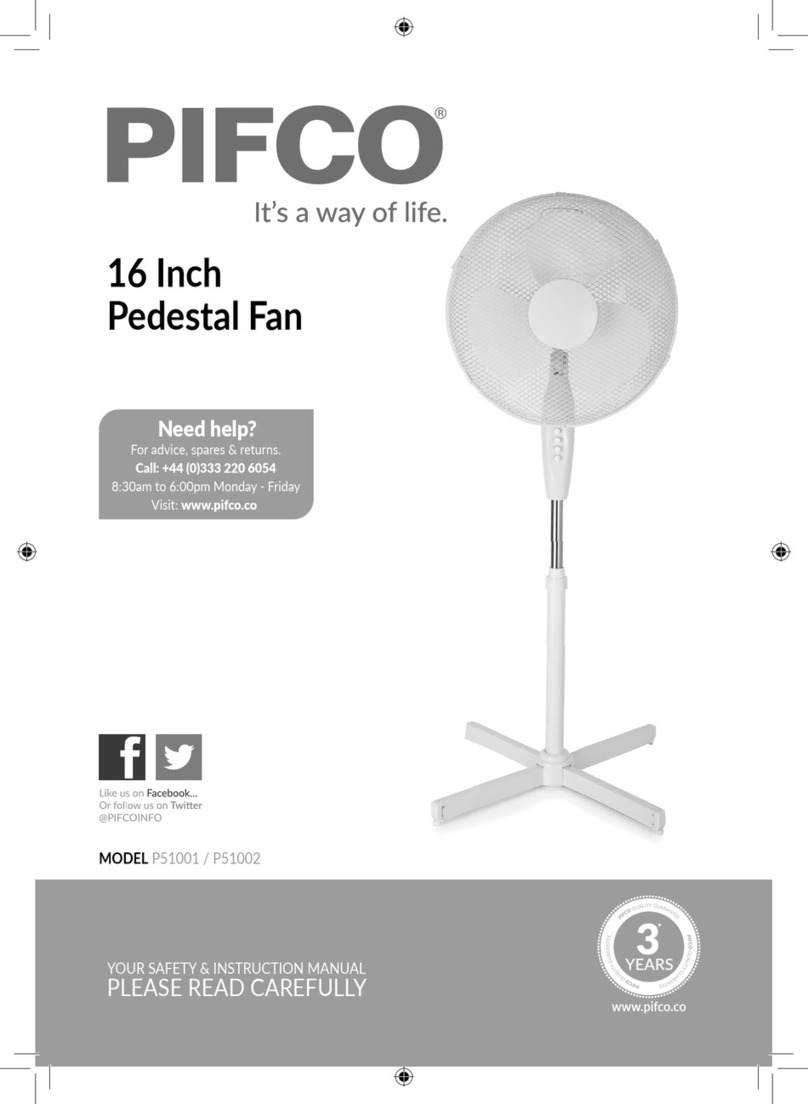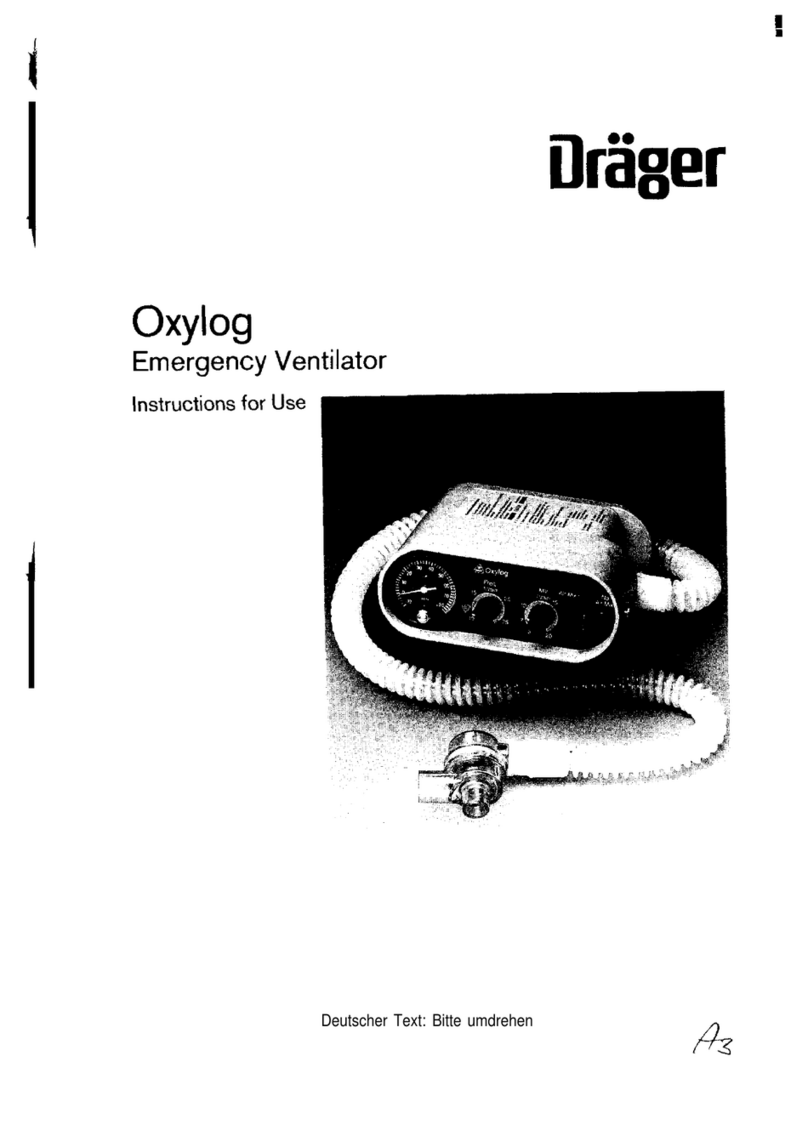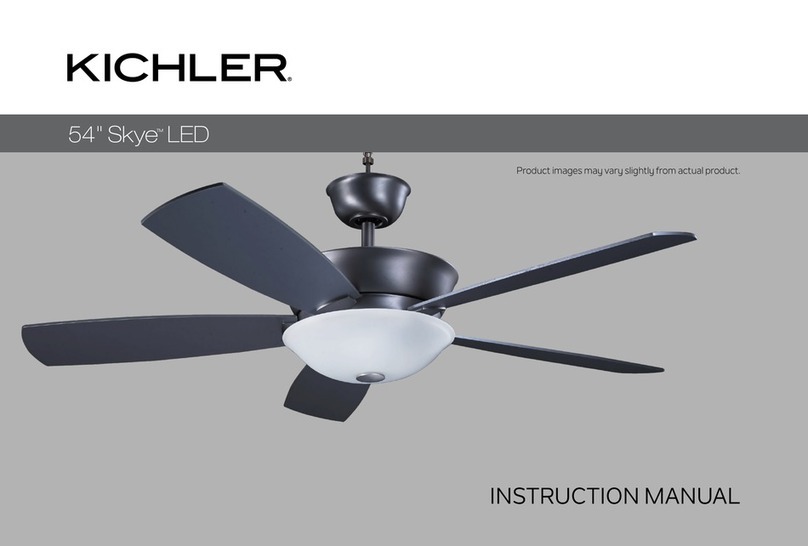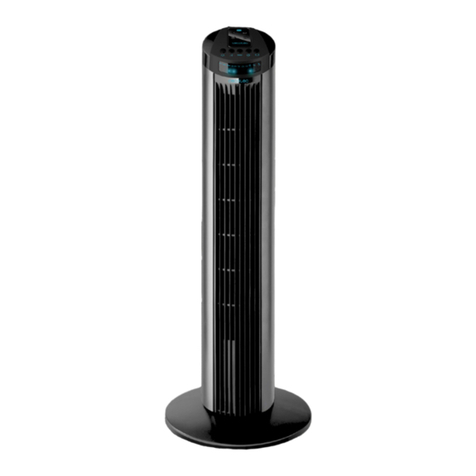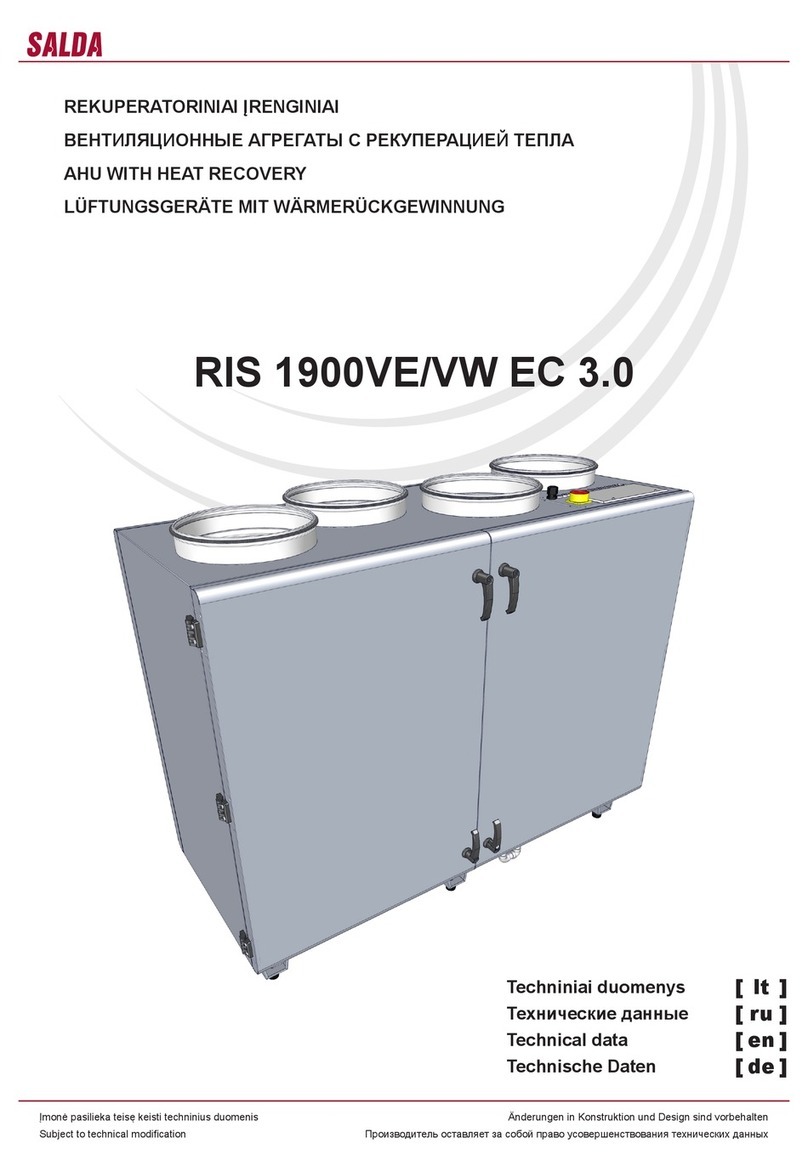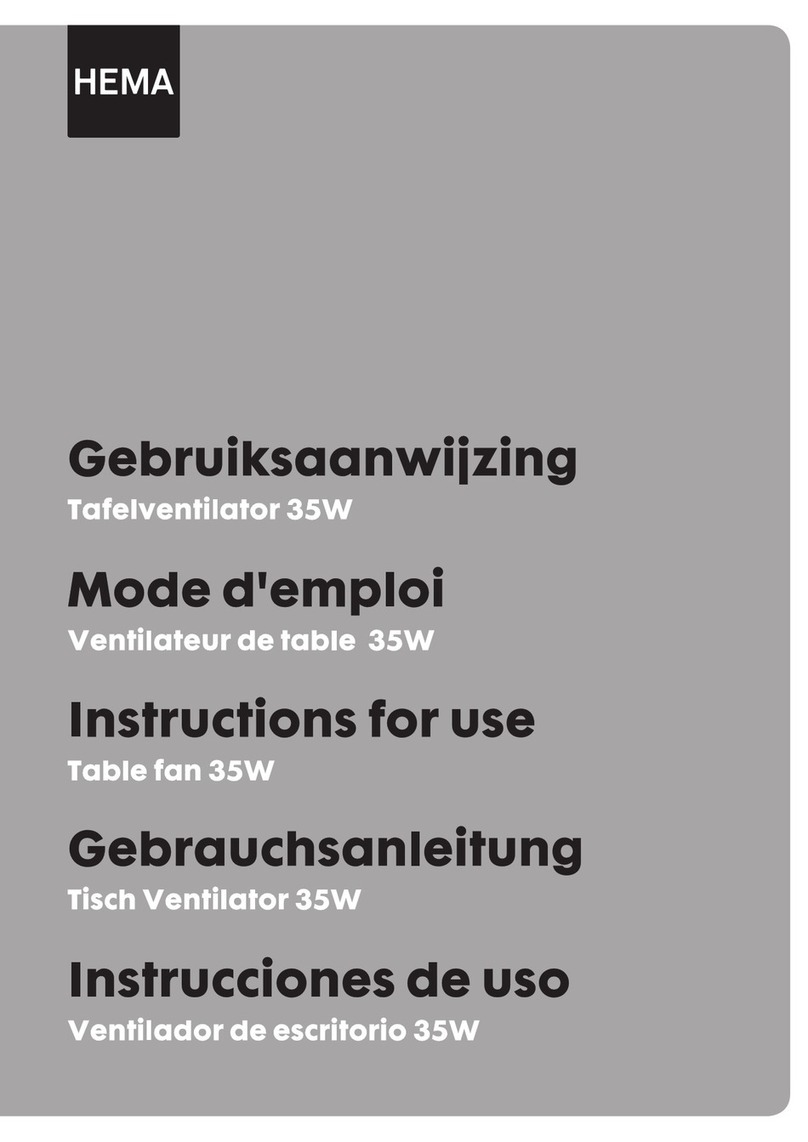Heatrae Sadia ADVANCE User guide

Advance / Advance Plus
Installer manual

Translation of the original document

Introduction
This manual is intended for use by the installer of the ventilation
system. It contains important information concerning installation,
use, maintenance and troubleshooting for the ventilation system.
The installer is responsible for installing and commissioning the
ventilation unit.
The following definitions are used in this manual to draw attention
to hazards, instructions or indications related to people, products,
installations and/or the surroundings.
ä Warning!
Indicates a hazard that can cause injury and/or severe damage
to the product, system or surrounding area.
ä Caution!
Instructions important for the installation, functioning, operation
or maintenance of the product. Failure to observe these
instructions can result in minor injury and/or severe damage to
the product, system or surrounding area.
Note
Instructions important for the installation, functioning, operation
or maintenance of the product. Failure to observe these
instructions can result in minor damage to the product, system
or surrounding area.
Tip
Instructions that may be important for the installation,
functioning, operation or maintenance of the product, but are
not related to injury or material damage.
Tip
Do not forget to register the product via the Heatrae Sadia
website. (www.heatraesadia.com/warranty_registration)
Although this manual has been drawn up with the utmost care, no
rights may be derived from this document.
Heatrae Sadia reserves the right to modify products and manuals
without prior notice.
Due to our continuous product improvement process, the
illustrations in this document may not match the delivered product.
The latest version (if available) can be downloaded from our
website via www.heatraesadia.com.
3

Contents
1. Safety and other regulations 5
2. Product information 7
2.1. Models 7
2.2. Accessories 7
2.3. Technical specifications 8
2.4. Capacity 8
2.5. Technical drawings 9
2.6. Parts 10
2.7. Controls 11
3. Installation 13
3.1. Installation requirements 13
3.2. Installing the ventilation unit 13
3.3. Connecting the condensate drain 21
3.4. Connecting the ducts 22
3.5. Electrical connection 23
4. Operation 24
4.1. Control options 24
4.2. RF-VI wireless remote control 24
4.3. Wireless control switch with timer 25
4.4. Wireless control switch with automatic control/
timer
26
4.5. Wired three-position switch 26
4.6. Pairing and unpairing RF remote controls 27
4.7. Pairing and unpairing RF sensors 27
5. Commissioning 28
5.1. Preparation 28
5.2. Putting into service 28
5.3. Adjusting the capacity 29
6. Inspection and maintenance 30
6.1. Inspection and maintenance schedule 30
6.2. Check for unusual noises 31
6.3. Inspecting and cleaning the fan 31
6.4. Inspecting and cleaning the bypass valve 32
6.5. Inspecting, cleaning and replacing filters 34
6.6. Maintenance 35
6.7. RF remote control maintenance 35
6.8. Inspection of additional RF sensors 35
6.9. Inspecting and cleaning air valves 35
6.10. Inspecting/cleaning ducts 35
7. Faults 36
8. Service parts 40
9. Warranty 42
10. Declarations 43
4

1. Safety and other regulations
äWarning!
●The specifications and settings of the
ventilation system comply exclusively with
the standards and statutes of the country
in which the ventilation system is sold.
Applications outside this country can lead
to very dangerous situations.
●The entire system must comply with the
current regulations as referred to in this
document and other applicable
documents provided by the manufacturer.
●All supplements, amendments and
regulations effective at the time of
installation are applicable for all
regulations.
●After installation, no health, safety or
environmental risks may be present in
accordance with the applicable CE
standards. This also applies to other
products included in the system.
●Do not use the product for purposes other
than those for which it is intended, as
described in this manual.
●Be careful when using electrical
appliances:
-Never touch the appliance with wet
hands.
-Never touch the appliance when
barefoot.
●This product and/or system may be
operated safely by children aged 12 years
and older and by people with physical,
sensory or mental disabilities or a lack of
experience/knowledge if under
supervision or after having received
instructions regarding safe use, and if they
are aware of the product and/or system
hazards.
●Cleaning and maintenance by the user
may not be done by children or people
with physical, sensory or mental
disabilities or a lack of experience/
knowledge without supervision.
●Do not allow children to play with the
product and/or system.
●Do not use the product in the vicinity of
flammable or volatile substances such as
alcohol, insecticides, petrol etc.
●Work may solely be performed on the
system by Heatrae Sadia or recognised
installers in accordance with the provisions
laid down in this manual. Only original
accessories and parts produced by the
manufacturer may be used for these
purposes.
●The system includes parts which may be
live. The installer should take the following
steps before carrying out work on an open
system:
-Disconnect power to the appliance or
system by unplugging the power cord
at the wall socket.
5

-Secure the appliance or system against
being switched on accidentally.
-The appliance includes moving parts.
When the plug is removed from the
wall socket, these parts will continue
moving for a few seconds. Therefore,
you should wait a minimum of 10
seconds before opening the appliance
after removing the plug.
äImportant!
●The safety instructions must be followed in
order to prevent physical injury and/or
damage to the product.
●Maintenance instructions must be
followed to prevent damage and
excessive wear and tear.
●The product may not be modified.
●The product is only suitable for use with a
230 V, 50 Hz AC power supply system.
●Ensure that the electrical system to which
the product is connected meets the
necessary conditions.
●Do not expose the product to the
elements.
●Do not place any objects on top of the
device.
●Inspect the product regularly for faults. In
the event of faults, immediately contact
your installer or Heatrae Sadia.
●Switch the product off if:
-The product is not working properly.
-You want to clean the outside of the
product.
●Ensure that the electrical circuit does not
become damaged.
●Do not use the device to extract air from
boilers, heating systems etc.
●Ensure that the device drains into a sewer
system which leads outside, and is
suitable and installed for this purpose.
●Ensure that air valves and grilles are not
obstructed, and that they are clean.
●Watch out for sharp and protruding duct
sections during periodic cleaning of air
valves and grilles.
6

2. Product information
The Advance and Advance Plus consist of a central balanced
ventilation unit with a heat recovery system and a duct connection
set. The Advance Plus is also equipped with an automatic bypass
valve. The operation of the bypass valve is described under Bypass
control on page 12.
2.1. Models
Models
Item Type Description
95060001 Advance Balanced ventilation unit with heat
recovery
95060007 Advance Plus Balanced ventilation unit with heat
recovery and bypass valve
2.2. Accessories
Accessories
Item no. Type Description
95970200 RF-VI
TRANSMITTER
Wireless RF-VI remote with LED signals,
three modes and timer function
95970003 RFT-
TRANSMITTER
W
Wireless RF control switch with three
settings and a timer function (White)
95970204 RFT-AUTO CO2 RF control switch with two positions,
automatic and timer functions
95970002 HRS-3I C Conventional wired switch with three
settings
95970201 RF-CO2 230 V RF CO2-sensor
95970203 RF-RH [BAT] RF-RH battery-powered sensor
95970202 RF-PIR RF-PIR battery-powered presence sensor
7

2.3. Technical specifications
Advance/Advance Plus
Dimensions (H x W x D) 760 x 597 x 290 mm
Weight 12 kg (including duct connection set)
Installation 2x 6 mm screws (not provided); on wall/ceiling/floor with min. load-bearing
capacity 200 kg/m2
Housing IP 30, double-insulated
Housing and insulation EPP housing (grey), PP hollow-core panel (internal), foamed PVC faceplates
(white)
Duct connection parts /
condensate drain
PP (black)
Motor module HIPS (black)
Filter caps TPE (RAL 7040)
Mounting brackets Galvanised steel
Filter class Standard G3 (dust filter for the first three months), then replace with G4 or F7
Duct nozzles (4x) Ø 125 mm, top side, with leak-safe seals
Heat exchanger Plastic counterflow exchanger (PS), not removable
Thermal efficiency Up to 91%
Condensate drain (2x) Ø 14 mm OD, PVC condensate hose (1 m), included
Temperature sensors 1x outside air temperature sensor; 1x exhaust air temperature sensor
Bypass control*Automatic control with built-in bypass valve on extraction side, 100%
Frost control Automatic frost protection (reduce fan speed at temperatures below -1°C)
Motor (1x) DC (CE) 120 W
Impellers (2x) PA plastic (backward curved)
Maximum power consumption 90 W
Power supply 230 V, 50 Hz, 4-wire power cable
Cable length 1.5 m (RAL 7001)
RF (built in) 100 m in free space, 868 MHz
Manual The user manual can also be placed in the bottom corner of the unit
* Applies exclusively to Advance Plus
2.4. Capacity
Capacity [m3/h] Pressure [Pa] Power [W]
Mode 1 minimum 25 12 4
Mode 1 standard 50 17 6
Mode 1 maximum 75 38 13
Mode 2 *100 70 26.5
Mode 3 minimum 75 38 13
Mode 3 standard 125 104 44
Mode 3 maximum 150 150 72
Mode 3 maximum 175 100 78
* Mode 2 is a calculated value, depending on the set minimum and maximum capacity.
Mode 1 and 3 can be adjusted using the potentiometers on the
motor module.
(see Adjusting the capacity on page 29).
8

2.5. Technical drawings
>50 (1) >50 (1)
>150 (1)
> 150 (1)
290 >360 (1)
B
5
5
4
1
3230V
2
76 76
425
132
86 86
122
A
760
597
(1) Minimum clearance around the ventilation unit
Number Description
1Exhaust air to outside
2Exhaust air from dwelling
3Supply air from outside
4Supply air to dwelling
5Condensate drain (2x)
9

2.6. Parts
7
9
8
4
6
5
1
3
2
7
9
8
4
6
5
1
3
2
10
Main components of Advance and Advance Plus
Number Description
1Ventilation unit
2Motor module
3Duct adapter EPP side
4Mounting bracket
5Duct adapter duct side
6Wire bracket
7Filter
8Filter cap
9Ceiling mounting bracket
10 Bypass valve *
* Applies exclusively to Advance Plus
10

2.7. Controls
The Advance and Advance Plus come as standard with three-
position control which allows the flow rates at low and high speed
to be adjusted as desired with the potentiometers on the unit. It is
also possible to pair RF sensors with the ventilation unit for
automatic ventilation control. In addition, the ventilation units have
some controls that operate continuously in the background.
The Advance Plus also has a bypass control which controls the
bypass valve (see Bypass control on page 12).
2.7.1. Optional sensors
A number of optional RF sensors are available for the Advance and
Advance Plus. When the ventilation unit is in Auto mode, the
capacity is adjusted continuously and automatically.
RF CO2 sensor
To ensure a healthy indoor climate and to prevent the air in the
dwelling from becoming stale, it is important that the CO2 (carbon
dioxide) concentration does not become too high.
The sensor can be placed in any room (except the bathroom), but
should preferably be placed in the living room or bedroom.
The sensor measures the CO2 concentration in the room. It
translates this CO2 concentration into a ventilation demand and
communicates this wirelessly to the ventilation unit paired with the
sensor. This allows ventilation to be continuously and automatically
adjusted, and it ensures that a good indoor climate is achieved in
the most effective and energy efficient manner.
This sensor can be used for "living area control", which causes the
ventilation capacity to be increased gradually in response to a rising
CO2 concentration. A "sleeping area control" is also available. In
this mode the ventilation capacity is increased more quickly in the
event of rising CO2 concentration because the extraction points are
generally further away from the sleeping area.
In addition, the user can choose between ECO or COMFORT mode
on the sensor. In COMFORT mode the system starts increasing the
capacity at relatively low CO2 concentration, resulting in more
ventilation.
Once the CO2 concentration has fallen sufficiently, the capacity is
automatically decreased.
RF-RH sensor
To ensure a healthy indoor climate and to prevent patches of damp
and mould in the dwelling, it is important that the relative humidity
does not stay high for too long.
The RF-RH sensor can be placed in any room, but preferably in the
bathroom and/or washroom.
This sensor measures the relative humidity in the room. The sensor
translates this relative humidity value into a ventilation demand and
communicates this wirelessly to the ventilation unit with which the
sensor is paired, or to a DF/QF controller with the room where it is
registered. This allows ventilation to be continuously and
automatically adjusted, and it ensures that a good indoor climate is
achieved in the most effective and energy efficient manner.
This sensor can be used for "bathroom control", which causes the
ventilation capacity to be increased quickly when there is a sudden
rise in relative humidity (for example during showering). Another
option is "washroom control", which causes the ventilation capacity
to increase gradually in response to rising relative humidity.
As soon as the relative humidity has fallen sufficiently, the capacity
is automatically decreased.
RF-PIR sensor
To ensure a healthy indoor climate and to prevent unpleasant
odours in the dwelling, it is important that there is enough
ventilation when people are present.
The RF-PIR sensor can be placed in any room, for example in the
toilet or in a bathroom with a toilet.
The sensor detects the presence (or absence) of people in the room
and communicates this wirelessly to the ventilation unit with which it
is paired. If the ventilation unit is in Auto mode, the capacity is
continuously and automatically adjusted.
If the sensor detects movement, the ventilation system runs at
increased capacity for a defined period. If the sensor detects
continuous occupancy of the room, the capacity will be increased
even more. If the motion sensor does not detect any movement
within a set period, the capacity will automatically be decreased
again.
This allows ventilation to be continuously and automatically
adjusted, and it ensures that a good indoor climate is achieved in
the most effective and energy efficient manner.
11

2.7.2. Bypass control
Solely the Advance Plus is equipped with a bypass valve in the
exhaust air line. This makes it possible to control what happens to
the (warm) exhaust air from the dwelling.
When the valve is in the normal position (closed), the exhaust air
from the dwelling passes through the heat exchanger and
exchanges heat with the cold supply air from outside.
If the valve is opened, the exhaust air no longer passes through the
heat exchanger, so there is no heat exchange. Although the outside
air still passes through the exchanger, the supplied outside air is
not warmed. This is desirable when it is warmer inside than outside
in the summer.
If in the summer it is cooler inside than outside, it is desirable to
cool the incoming air ("cold recovery"). In this case, the valve is
closed so that the relatively cool indoor air again passes through
the exchanger.
The position of the bypass valve is automatically determined using
the measured outdoor temperature and the measured exhaust air
temperature.
2.7.3. Frost control
The Advance and Advance Plus have an automatic control which
protects the heat exchanger against freezing. If the measured
outside air temperature is lower than -1°C, the fan is gradually
slowed down and eventually brought to a standstill. In this case, the
unit will still respond to the timer (see "Operation"). The ventilation
unit also checks whether the temperature has risen sufficiently for
the fan to be switched back on.
Note
If the ventilation unit must continue running when the outside
temperature is lower than -1°C in order to ensure sufficient
ventilation, Heatrae Sadia advises using an external heater in the
supply duct for outside air. The temperature setpoint for this
must be -1°C.
2.7.4. Dirty filter control
The control of the Advance and Advance Plus uses a smart counter
to keep track of when the filters need to be cleaned or replaced.
This counter takes into account air quality, the service life of the
filter and the fan speed. If the system detects that a filter is dirty,
the ventilation unit sends a wireless message to this effect. This
message can be displayed on specific paired devices, such as the
RFT-L or the RF-VI (ventilation interface).
12

3. Installation
3.1. Installation requirements
ä Caution!
In order to prevent condensation, the duct from outside and the
duct leading outside must be thermally insulated and vapour-
tight right up to the ventilation unit.
Take the following into account when positioning the system:
●Install the ventilation unit:
- in a closed area (where the system can cause as little noise
disturbance as possible);
- in a frost-free area;
- in the vicinity of a 230 V AC 50 Hz power point; the length
of the power cable is 1.5 m;
- in the vicinity of a trap with a sewer connection (for
connecting the condensate drain);
- by mounting it on a wall/ceiling/floor with sufficient load-
bearing capacity (min. 200 kg/m2).
●When positioning the ventilation unit, ensure that you also
leave enough space for servicing the system.
For this purpose, a minimum of 150 mm clearance should be left at the
top and bottom of the unit, and 350 mm at the front (see Technical
drawings on page 9).
●The duct system and the outlet and inlet points must be
correctly dimensioned.
●The correct fixing materials must be available.
Tip
In order to avoid noise complaints, Heatrae Sadia advises fitting
silencers on the ducts from and to the dwelling rooms.
3.2. Installing the ventilation unit
3.2.1. Unpacking and checking
a) Carefully remove the appliance from the box. If necessary, use
the handle on top of the motor module to remove the
ventilation unit from the box in an upright position.
b) Check that the nameplate information and the type correspond
to the sticker on the outside of the box.
c) Check the appliance for damage and completeness.
d) Check that user and installer manuals, a ceiling mounting
bracket and a condensate hose are included with the ventilation
unit.
13

e) Place the ventilation unit upright on the floor, with the duct
adapters at the top.
f) Remove the two wire brackets from the unit and set them aside.
g) Unlock both duct adapters on the front of the unit using a flat-
head screwdriver. Then remove both adapters, which are
connected together by the mounting bracket, from the unit
simultaneously.
2x
h) Then remove both duct adapters from the mounting bracket
and put everything to one side.
14

3.2.2. Mounting positions
ä Caution!
Mount the ventilation unit on a concrete surface, not on a
wooden or plaster surface or a surface with insufficient load-
bearing capacity (<200 kg/m2), since that may lead to excessive
noise.
ä Caution!
Always ensure that the ventilation unit is installed with the ducts
connected to the correct air inlets and outlets.
ä Caution!
If the ventilation unit is mounted "inversely", the duct adapters
must be swapped.
The ventilation unit can be mounted on the wall, floor or ceiling.
Depending on the configuration of the ducts, the ventilation unit
can be wall mounted with the standard duct adapter
arrangement (as delivered) or the inverse arrangement (see
Converting before mounting).
The standard arrangement is always used for floor mounting, and
the inverse arrangement must always be used with ceiling
mounting. This is due to condensation water path in the heat
exchanger.
The symbols on the ventilation unit indicate which ducts should
be connected to which openings.
15

Mounting positions
Wall mounting, standard Wall mounting, inverse 1
A
B
Floor mounting, standard Ceiling mounting, inverse 1
A
B
1 See Converting before mounting on page 17.
Exhaust air to outside Exhaust air from dwelling
Supply air from outside Supply air to dwelling
16

3.2.3. Converting before mounting
The Advance and Advance Plus are delivered as standard with the
air inlet ducts on the wall side (mounting bracket side). This is the
correct position for wall and floor mounting.
For ceiling mounting, or if this is more convenient with wall
mounting, the ventilation unit can easily be inverted. If this is not
necessary, the following section can be ignored.
a) Pull both ventilation unit adapters out of the EPP housing.
I
II
b) There is a blue seal ring on the underside of each adapter.
Check whether these rings are fitted correctly to the adapters.
I
II
c) Rotate both ventilation unit adapters by 180°.
II
I
d) Press the ventilation unit adapter that was on the left side into
the right side of the EPP housing, and press the ventilation unit
adapter that was on the right side into the left side of the EPP
housing (thereby switching the adapter positions).
II
I
The ventilation unit is now "inverted" and ready to be mounted.
17

3.2.4. Wall mounting
a) Attach the mounting bracket to the wall using anchor plugs and
6 mm screws (not provided).
425 (2)>125 (1) >125 (1)
>920 (1) >170 (1)
(575)
(1) Minimum clearance around the ventilation unit
(2) Distance between hole centres
ä Caution!
Ensure that the mounting bracket is mounted horizontally and
level for proper condensate drainage.
b) Slip the duct adapters back over the mounting bracket and
push the two adapters to the left and to the right as far as they
will go.
c) Hook the two wire brackets onto the outside of the duct
adapters using the holes intended for this purpose.
2x
ä Caution!
There is only one way to insert the ventilation unit adapters into
the duct adapters.
d) Place the ventilation unit in the wire brackets, tilted forward
slightly. There are recesses on the underside of the EPP
housing into which the wire brackets fit exactly. When the
adapters have been fully inserted into one another, you will
hear a distinct click. This means the unit is firmly attached.
2x
18

3.2.5. Ceiling mounting
ä Caution!
With this mounting option, the ventilation unit needs to be
mounted with enough tilt to ensure correct condensate
drainage. It is also important to ensure that the condensate
hose can be mounted with a slope from the ventilation unit to
the condensate drain.
a) Attach the mounting bracket and the ceiling bracket to the
ceiling using anchor plugs and 6 mm screws (not provided).
50
760
425 (2)>125 (1) > 125(1)
>170 (1)>920 (1)
(575)
1 Minimum clearance around the ventilation unit
2) Distance between hole centres
ä Caution!
There is only one way to insert the ventilation unit adapters into
the duct adapters.
b) Slip the duct adapters back over the mounting bracket and
push the two adapters to the left and to the right as far as they
will go.
c) Place the ventilation unit in the ceiling mounting bracket, tilted
forward slightly. There is a recess on the underside the EPP
housing into which the bracket fits exactly.
d) Tilt the ventilation unit backwards so that the ventilation unit
adapters slide under the duct adapters. When the adapters
have been fully inserted into one another, you will hear a
distinct click. This means the unit is firmly attached.
19

e) Now secure both wire brackets. First hook each bracket onto
the outside of the duct adapter using the holes intended for
this purpose, and then clip the underside of the bracket into the
underside of the housing of the ventilation unit. There is a
recess on the underside of the EPP housing into which the
bracket fits exactly.
2x 2x
Note
The position of the ceiling bracket may need to be readjusted.
To do so, loosen the screws a little and shift the bracket in the
oversize holes.
3.2.6. Floor mounting
ä Caution!
With this mounting option, the ventilation unit needs to be
mounted with enough tilt to ensure correct condensate
drainage. It is also important to ensure that the condensate
hose can be mounted with a slope from the ventilation unit to
the condensate drain.
a) Attach two wooden laths (50 x 100 x 600 mm and 50 x 50 x
600 mm, not provided) to the floor as shown in the diagram
below.
50
50
50
100
580
50
b) Secure the mounting bracket to the higher of the two laths
using 6 mm screws (not provided).
ä Caution!
There is only one way to insert the ventilation unit adapters into
the duct adapters.
c) Slip the duct adapters back over the mounting bracket and
push the two adapters to the left and to the right as far as they
will go.
20
This manual suits for next models
1
Table of contents
Other Heatrae Sadia Fan manuals
